As a lifelong feline enthusiast, I’ve always been captivated by the myriad patterns and personalities that different cat breeds offer. Among these, the Lynx Ragdoll holds a special place in my heart.
This particular pattern combines the striking tabby-like markings of the lynx with the distinctive inverted ‘V’ facial marking characteristic of bicolor Ragdolls, creating a cat that’s as mesmerizing in appearance as it is in temperament.
What sets the Lynx Bicolor Ragdoll apart from other Ragdoll patterns is its unique blend of features. The lynx pattern introduces subtle striping, reminiscent of wildcats, adding an extra layer of visual interest to the already charming bicolor design.
This combination not only enhances their aesthetic appeal but also showcases the breed’s genetic diversity. Beyond their captivating looks, Lynx Bicolor Ragdolls are renowned for their affectionate and gentle nature.
Often described as “puppy-like,” they form deep bonds with their human companions, following them from room to room and relishing in cuddle sessions. Their calm demeanor and adaptability make them ideal companions for families, singles, and seniors alike.
For a comprehensive understanding of the Lynx Bicolor Ragdoll breed, here’s a detailed overview:
Breed Overview
| Trait | Description |
| Origin | Developed in the 1960s by breeder Ann Baker in California. |
| Size | Large; males typically weigh between 15–20 pounds, females between 10–15 pounds. |
| Coat | Semi-long, silky, and plush; requires regular grooming to prevent matting. |
| Color Patterns | Lynx Bicolor pattern features tabby-like striping with an inverted ‘V’ on the face; body color is lighter with darker points on ears, tail, and saddle area. |
| Eye Color | Striking blue hues ranging from light to deep sapphire. |
| Personality | Affectionate, docile, and sociable; enjoys human interaction and is known to be good with children and other pets. |
| Activity Level | Moderate; enjoys playtime but also appreciates lounging and cuddle sessions. |
| Lifespan | Approximately 12–15 years with proper care. |
| Health Concerns | Generally healthy but can be prone to hypertrophic cardiomyopathy (HCM); regular veterinary check-ups are recommended. |
| Special Traits | Known for going limp when picked up, a trait that inspired the name “Ragdoll.” |
Embracing a Lynx Bicolor Ragdoll into your home means welcoming a blend of beauty, grace, and unwavering affection—a true testament to the charm of this remarkable breed.
What is a Lynx Bicolor Ragdoll?
Table of Contents

The Lynx Bicolor Ragdoll is a stunning variation of the Ragdoll breed that combines the lynx (tabby) pattern with the classic bicolor markings.
This mix creates a cat with striking facial and body patterns while maintaining the signature soft, plush coat and affectionate personality that Ragdolls are known for.
Their unique appearance sets them apart from other Ragdoll patterns, making them highly sought after by cat lovers.
Explanation of the Lynx Pattern in Ragdolls
The lynx pattern in Ragdolls is characterized by faint tabby-like striping on the forehead, legs, and tail. These markings result from the agouti gene, which controls the distribution of color along each hair shaft, creating the signature tabby stripes.
Lynx Ragdolls also have an “M” marking on their forehead, a common trait among tabby-patterned cats. Their ears often feature a lighter outline, and their eyes are accentuated by subtle white spectacles, enhancing their expressive look.
Unlike traditional tabby cats, Lynx Ragdolls still have a pointed coloration, meaning their extremities (ears, tail, and face) are darker than the rest of their body. This contrast adds depth to their already beautiful appearance.
What Does Bicolor Mean in Ragdolls?
Bicolor refers to a distinct pattern in Ragdolls where the cat has a symmetrical, inverted “V” of white on its face, along with a predominantly white underbelly, chest, and legs.
The back, tail, and ears are colored, with the contrast between the two shades creating a visually balanced look.
In Lynx Bicolor Ragdolls, the combination of lynx striping and bicolor markings results in a unique coat pattern that is more dynamic than traditional bicolor Ragdolls.
While the base color may include blue, seal, lilac, or chocolate, the bicolor division remains consistent, giving the cat a distinctive and appealing appearance.
Differences Between Lynx Bicolor and Other Ragdoll Patterns
The main difference between Lynx Bicolor Ragdolls and other Ragdoll patterns lies in their striped markings. While traditional bicolor Ragdolls have solid-colored patches, Lynx Bicolors display faint tabby-like striping.
Compared to mitted Ragdolls, Lynx Bicolors lack the mitten-like white paws that define the mitted pattern. Similarly, they differ from colorpoint Ragdolls, which lack white markings altogether.
This makes Lynx Bicolor Ragdolls stand out as a perfect blend of elegance and uniqueness.
Lynx Bicolor Ragdoll Color Variations
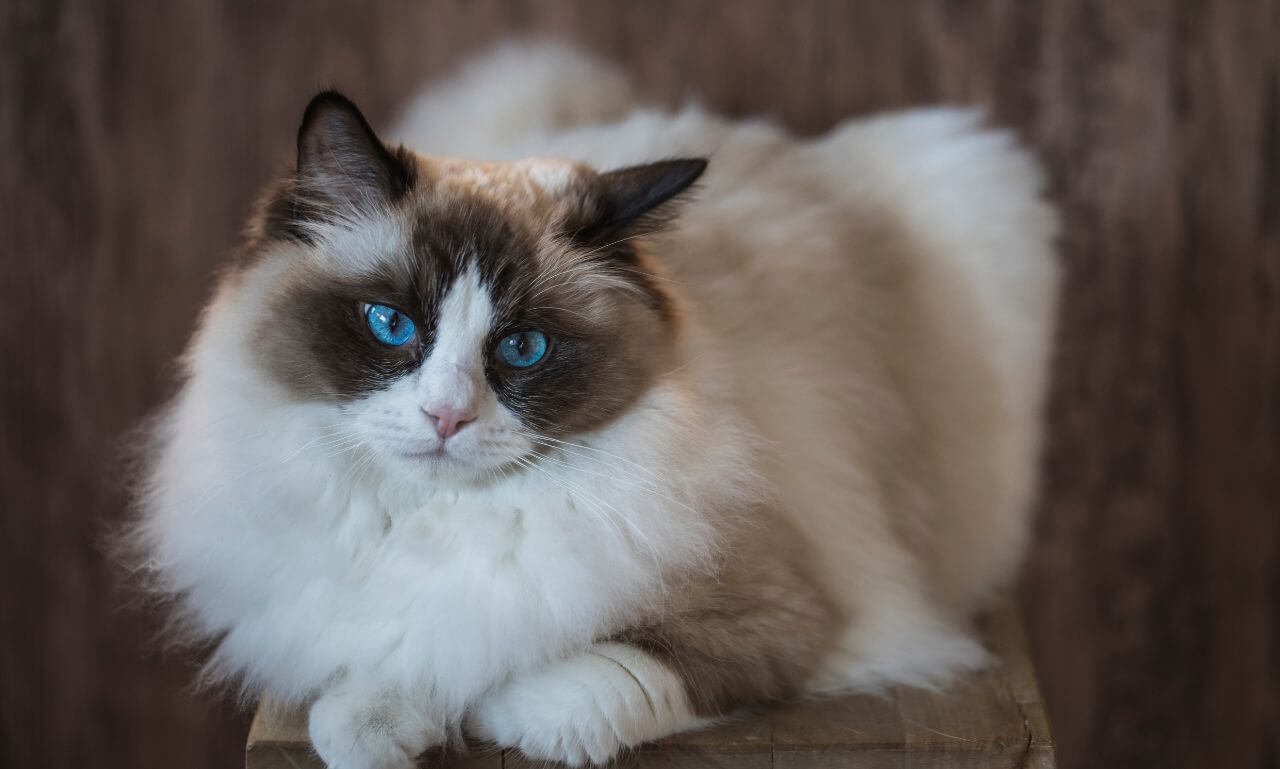
Lynx Bicolor Ragdolls come in a variety of stunning colors, each with its own unique charm. Their distinctive bicolor pattern, combined with soft tabby striping, creates an elegant and striking appearance.
While all Lynx Bicolor Ragdolls share the same tabby-influenced markings, their coat colors can range from soft blues to rich chocolates and deep seals.
As these cats mature, their coat color and patterns may change, making each Ragdoll unique throughout its life.
Understanding the different Lynx Bicolor Ragdoll color variations can help prospective owners choose the perfect cat for their home.
Blue Lynx Bicolor Ragdoll
The Blue Lynx Bicolor Ragdoll is one of the most popular color variations, featuring a soft blue-gray coat contrasted with white patches. Their lynx pattern is subtle but noticeable, with delicate striping on the forehead, legs, and tail.
- Their eyes are a deep, captivating blue, making them one of the most striking Ragdoll variations.
- The characteristic white paws and inverted ‘V’ facial marking enhance their gentle, angelic appearance.
- Blue Lynx Bicolor kittens may start with a very light coat, gradually developing their signature blue-gray tones as they age.
Blue Lynx Bicolor Ragdoll Kitten
At birth, Blue Lynx Bicolor Ragdoll kittens often appear nearly white with faint undertones of their future blue-gray color. Over the first few months, their tabby markings and color points begin to emerge.
- Their fur is soft and fluffy, requiring gentle brushing to prevent matting.
- A high-quality diet rich in protein and essential fatty acids supports healthy coat development.
- Their playful and affectionate nature makes them excellent companions, but early socialization is key.
Chocolate Lynx Bicolor Ragdoll
Chocolate Lynx Bicolor Ragdolls are rarer than their blue counterparts, featuring warm, brownish tones that contrast beautifully with their white markings.
- Their coat has a milk-chocolate hue, giving them a luxurious and unique appearance.
- Compared to Blue Lynx Bicolors, their markings are warmer and more pronounced.
- Their soft, plush fur requires regular grooming to maintain its rich color and silky texture.
Lilac Lynx Bicolor Ragdoll
The Lilac Lynx Bicolor Ragdoll is known for its pale, pastel-like grayish tones. This delicate coloration makes them one of the most visually striking and elegant Ragdolls.
- Their markings are a cool, frosty lavender-gray, giving them an ethereal appearance.
- Lilac Ragdolls can sometimes be confused with Blue Lynx Bicolor, but lilacs have a softer, more diluted coloration.
- They are gentle, and affectionate and thrive in loving, interactive households.
Seal Lynx Bicolor Ragdoll Kitten
Seal Lynx Bicolor Ragdoll kittens are born with lighter coats, but their color darkens as they grow.
- Their lynx pattern features deep brown tabby-like stripes on their points.
- Over time, their coat develops a rich seal-brown contrast against their white markings.
- They are playful and energetic as kittens but become relaxed and affectionate as they mature.
Seal Mink Lynx Bicolor Ragdoll
Mink Ragdolls have a genetic makeup different from traditional Ragdolls, resulting in a richer and softer coat.
- Seal Mink Lynx Bicolor Ragdolls have a deeper, more intense coloration compared to standard Seal Lynx Bicolor.
- Their coats are silkier and appear more velvety, with stronger contrast between their dark points and lighter bodies.
- Their eye color can range from deep blue to aqua, unlike traditional Ragdolls, which only have blue eyes.
Lynx Bicolor Ragdoll Kitten
When adopting a Lynx Bicolor Ragdoll kitten, it’s important to understand their early developmental stages.
- The best age to adopt a Lynx Bicolor Ragdoll kitten is around 12–16 weeks when they are fully weaned and socialized.
- Early training, including litter box habits and social interaction, helps them grow into well-behaved adult cats.
- Their affectionate nature means they thrive on companionship and do best in homes where they receive plenty of attention.
Blue Lynx Bicolor Ragdoll Adult
As Blue Lynx Bicolor Ragdolls grow into adulthood, their coat and eye colors may shift slightly.
- Their blue-gray coat deepens over time, with well-defined lynx striping.
- Grooming becomes essential, as their semi-long fur is prone to matting if not brushed regularly.
- They continue to be affectionate and social, often following their owners around the house and enjoying cuddle time.
Lynx Bicolor Ragdolls, regardless of their color variation, are among the most affectionate and visually captivating Ragdolls.
Their unique blend of tabby markings and bicolor contrast makes them a standout choice for cat lovers looking for a loyal and beautiful companion.
Personality and Temperament of Lynx Bicolor Ragdolls
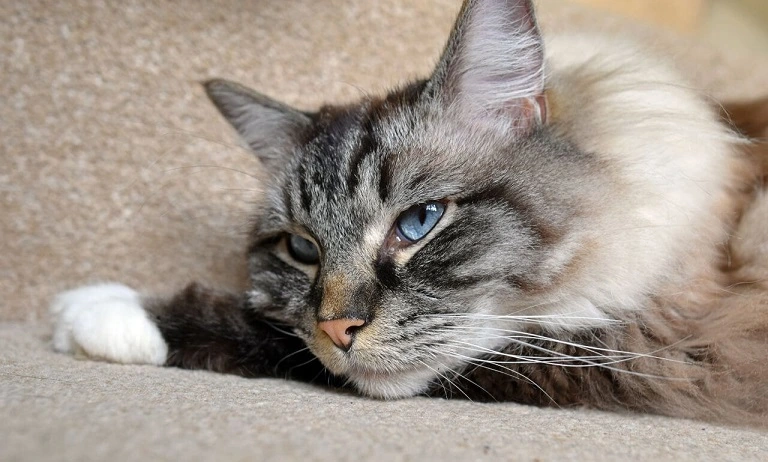
Lynx Bicolor Ragdolls are renowned for their affectionate, easygoing, and social personalities. These cats thrive on human interaction and are often referred to as “puppy-like” because of their loyalty and tendency to follow their owners around the house.
Their gentle temperament makes them one of the best companion cats, especially for families and multi-pet households.
Affectionate and Lap-Cat Nature
Ragdolls, including the Lynx Bicolor variety, are known for their love of cuddles and close companionship with their owners.
- They enjoy being held and often go limp in their owner’s arms, which is how the breed got its name.
- Unlike more independent cat breeds, Lynx Bicolor Ragdolls actively seek attention and affection.
- They are not overly vocal but will softly communicate their needs, whether it’s for food, playtime, or simply to be near their favorite human.
Intelligence and Trainability
Despite their calm demeanor, Lynx Bicolor Ragdolls are highly intelligent and can learn various tricks and commands.
- Many owners successfully train them to play fetch, respond to their names, and even perform simple tricks.
- They are one of the few cat breeds that can be leash-trained, making them great companions for outdoor walks.
- Their intelligence also means they can quickly adapt to changes in routine, though they prefer a stable, predictable environment.
Interaction with Kids, Other Pets, and New Environments
Lynx Bicolor Ragdolls are one of the most sociable cat breeds, making them ideal for families with children and other pets.
- Their patient and gentle nature allows them to tolerate young children who may not yet understand how to handle cats properly.
- They get along well with dogs and other cats, provided they are introduced gradually and in a positive manner.
- Due to their calm disposition, they adjust well to new environments, whether moving to a new home or traveling with their owners.
Their affectionate, intelligent, and adaptable personality makes the Lynx Bicolor Ragdoll a perfect choice for those seeking a loving feline companion who thrives on human interaction.
Care and Grooming Needs
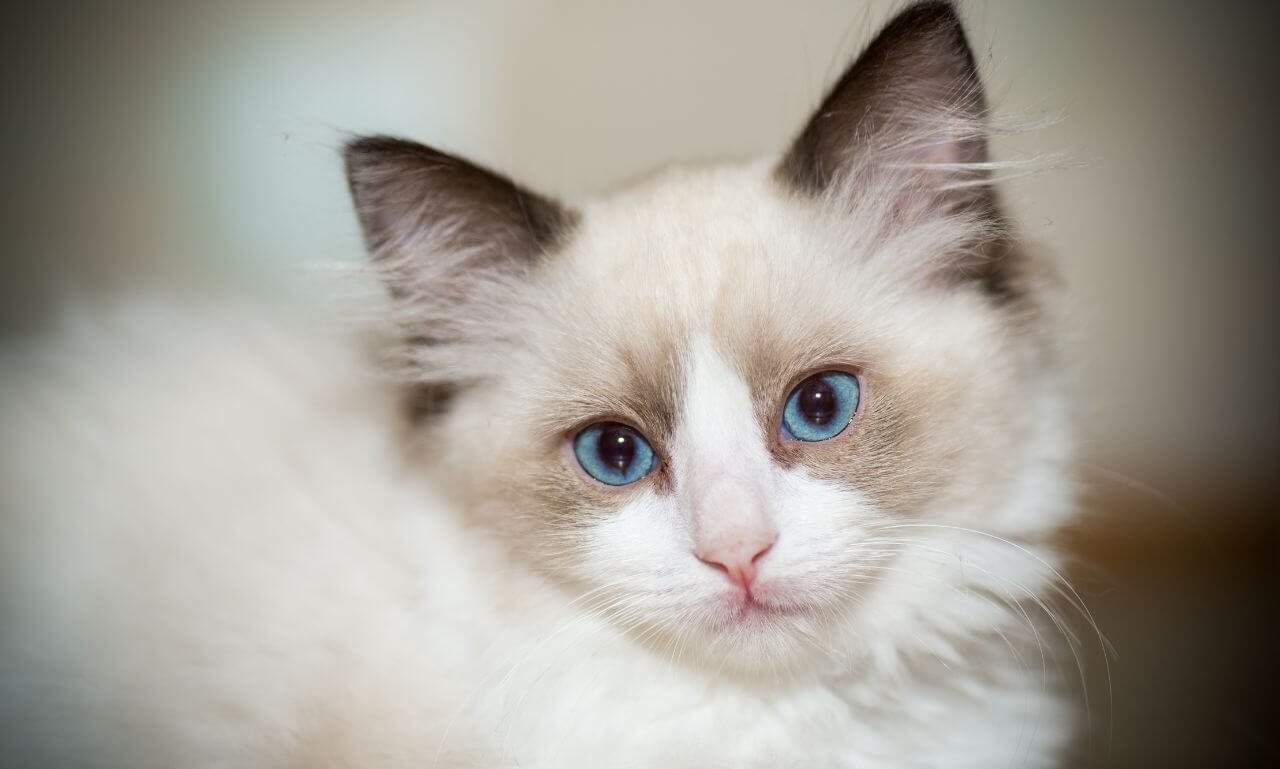
Lynx Bicolor Ragdolls require a well-balanced diet, regular grooming, and proper health monitoring to ensure they live long, healthy lives. While they are relatively low-maintenance compared to some other long-haired breeds, their care routine should not be neglected.
Dietary Requirements for Lynx Bicolor Ragdolls
A high-quality diet is essential for maintaining the health and luxurious coat of a Lynx Bicolor Ragdoll.
- Protein-Rich Diet – As obligate carnivores, they thrive on high-protein, meat-based diets. Choose quality wet or dry food with real meat (chicken, turkey, fish) as the primary ingredient.
- Balanced Nutrients – Omega fatty acids help maintain their soft, plush coat, while taurine supports heart and eye health.
- Portion Control – Ragdolls are prone to obesity due to their laid-back nature. Feeding them measured portions and limiting excessive treats helps prevent weight gain.
- Hydration – Encourage drinking water by providing a fresh water source or using a pet water fountain. Wet food can also help with hydration.
Grooming Routine: Managing Their Semi-Long Fur
Lynx Bicolor Ragdolls have a silky, semi-long coat that requires regular grooming to prevent tangles and keep their fur in top condition.
- Brushing Frequency – Brush their coat at least 2-3 times a week using a stainless steel comb or soft-bristle brush to remove loose hair and prevent matting.
- Shedding Control – While Ragdolls shed less than some long-haired breeds, they do have seasonal shedding periods. More frequent brushing during these times helps manage loose fur.
- Bathing Needs – Ragdolls typically do not require frequent baths, but occasional bathing (every few months) can help keep their coat clean. Always use a cat-friendly shampoo.
- Eye and Ear Cleaning – Gently wipe their eyes if tear stains develop and check their ears weekly for signs of wax buildup or infection.
- Nail Trimming – Trim their nails every 2-3 weeks to prevent overgrowth and scratching.
Common Health Concerns
Lynx Bicolor Ragdolls are generally healthy but can be predisposed to some genetic health conditions.
- Hypertrophic Cardiomyopathy (HCM) – A common heart disease in Ragdolls, causing thickening of the heart muscle. Regular veterinary check-ups can help detect early signs.
- Kidney Issues – Polycystic Kidney Disease (PKD) and urinary tract infections can affect Ragdolls. A proper diet with adequate hydration helps prevent these issues.
- Obesity – Due to their relaxed nature, they can become overweight if not given proper exercise and portion control in their diet.
Regular veterinary check-ups, proper nutrition, and a consistent grooming routine ensure that Lynx Bicolor Ragdolls stay healthy and maintain their stunning appearance.
Where to Find Lynx Bicolor Ragdoll Kittens for Sale
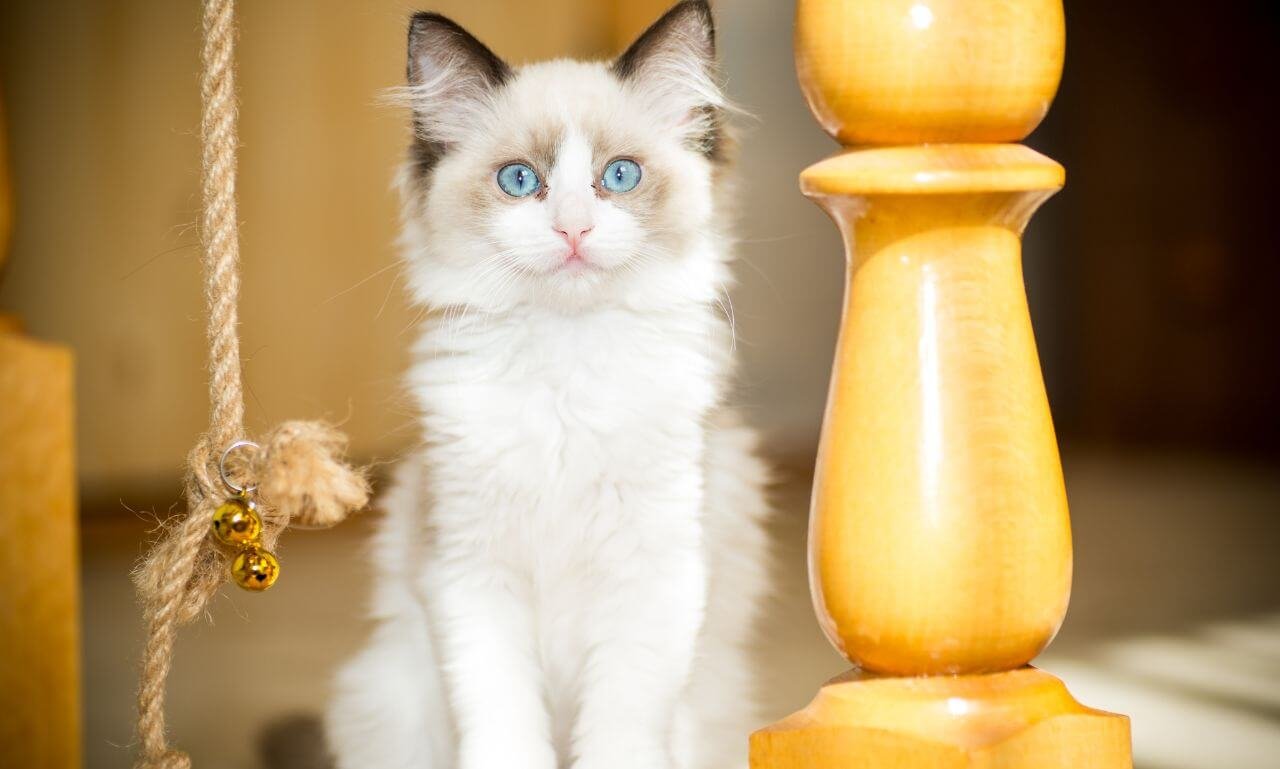
Finding a healthy and well-socialized Lynx Bicolor Ragdoll kitten requires careful research and choosing a reputable breeder or adoption center.
Whether purchasing from a breeder or adopting from a rescue, it’s essential to ensure the kitten is raised in a loving and ethical environment.
How to Choose a Reputable Ragdoll Breeder
Selecting a responsible breeder is crucial in getting a healthy Lynx Bicolor Ragdoll with proper lineage and good temperament. Consider the following factors when choosing a breeder:
- Registered and Ethical Breeding Practices – Look for breeders registered with organizations like The International Cat Association (TICA) or Cat Fanciers’ Association (CFA) to ensure ethical breeding standards.
- Health Screening and Genetic Testing – A reputable breeder should provide health certifications, including tests for Hypertrophic Cardiomyopathy (HCM) and Polycystic Kidney Disease (PKD)—common concerns in Ragdolls.
- Kitten Socialization – Ask the breeder about early socialization practices. Kittens raised in a home environment and exposed to human interaction tend to develop better temperaments.
- Transparency – A trustworthy breeder will allow potential buyers to visit their cattery, meet the kittens and their parents, and provide a health guarantee.
Price Range for Different Color Variations
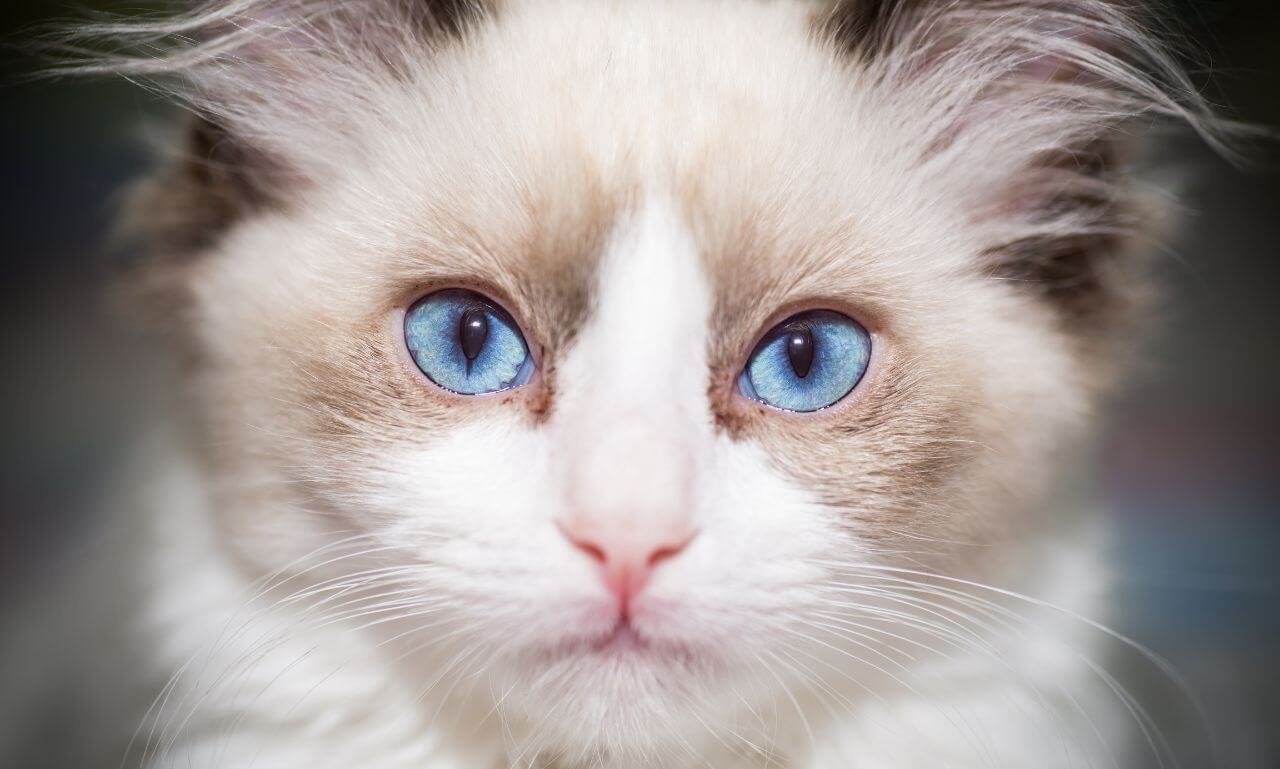
The cost of a Lynx Bicolor Ragdoll kitten varies based on factors such as coat color, lineage, and breeder reputation. Here’s a general price range:
| Color Variation | Price Range (USD) |
| Blue Lynx Bicolor Ragdoll | $1,500 – $3,500 |
| Chocolate Lynx Bicolor Ragdoll | $2,000 – $4,000 |
| Lilac Lynx Bicolor Ragdoll | $2,000 – $4,500 |
| Seal Lynx Bicolor Ragdoll Kitten | $1,800 – $3,500 |
| Seal Mink Lynx Bicolor Ragdoll | $2,500 – $5,000 |
Show-quality kittens from champion bloodlines tend to be on the higher end, while pet-quality kittens are more affordable.
What to Look for When Adopting from a Breeder vs. a Rescue
There are two main ways to bring home a Lynx Bicolor Ragdoll—buying from a breeder or adopting from a rescue. Each option has its considerations:
Buying from a Breeder
- Ideal for those looking for a kitten with a known lineage, proper health screening, and desired color variations.
- Kittens are usually raised in a controlled environment with early socialization.
- Expect a waiting list for rare colors like Chocolate and Lilac Lynx Bicolors.
Adopting from a Rescue
- Ragdoll rescues and shelters occasionally have adult Lynx Bicolor Ragdolls in need of a home.
- Adoption fees range from $100 to $500, significantly lower than purchasing from a breeder.
- Rescued cats may require extra patience and socialization, but they make wonderful companions.
To find available kittens or rescues, check reputable breeder websites, TICA/CFA listings, or Ragdoll cat rescue organizations. Always verify the breeder’s or shelter’s credentials before making a decision.
Conclusion
The Lynx Bicolor Ragdoll is a stunning and affectionate breed, combining the elegance of tabby-like markings with the signature Ragdoll charm.
Their striking patterns, coupled with their loving and social personalities, make them a perfect choice for families, singles, and multi-pet households alike. Whether in Blue, Chocolate, Lilac, or Seal variations, each Lynx Bicolor Ragdoll carries a unique beauty that captivates cat lovers.
If you are considering adding a Lynx Bicolor Ragdoll kitten to your home, be prepared for a devoted and gentle companion who will thrive on attention and affection.
Their intelligence and adaptability make them easy to train, while their playful yet relaxed nature ensures they fit well into various lifestyles.
When choosing your perfect kitten, always go through reputable breeders or ethical rescues to ensure a healthy and well-socialized pet.
With the right care, a Lynx Bicolor Ragdoll will reward you with years of love, loyalty, and companionship—making them a truly special addition to any home.
Frequently Asked Questions
What is the difference between lynx and bicolor Ragdolls?
The term “Lynx” refers to tabby-like markings on the face, legs, and tail, while “Bicolor” refers to a coat pattern with a white inverted ‘V’ on the face, white paws, and a mostly white underside. A Lynx Bicolor Ragdoll has both features combined.
Are lynx Ragdolls more expensive?
Lynx Ragdolls can be slightly more expensive than standard Ragdolls due to their unique markings and popularity. However, the price also depends on the breeder, lineage, and coat color.
Are lynx Ragdolls rare?
Lynx Ragdolls are not extremely rare but are less common than traditional Ragdoll patterns. Certain colors, such as Chocolate and Lilac Lynx Bicolor, are particularly rare due to their recessive genes.
What is a lynx Ragdoll?
A Lynx Ragdoll is a Ragdoll cat with tabby-like striping on the face, legs, and tail, along with a distinctive “M” marking on the forehead. This pattern results from the agouti gene interacting with the traditional Ragdoll colorations.
What is the rarest Lynx Bicolor Ragdoll color?
The Lilac and Chocolate Lynx Bicolor Ragdolls are among the rarest due to their recessive genes.
Do Lynx Bicolor Ragdolls change color as they grow?
Yes, their markings and shades deepen as they mature, especially in Blue and Seal variations.
Are Lynx Bicolor Ragdolls hypoallergenic?
No, but they produce less Fel d 1 protein than some other cat breeds, making them a better option for mild allergy sufferers.
How big do Blue Lynx Bicolor Ragdolls get?
Males can weigh 15–20 lbs, while females range from 10–15 lbs at full maturity.
What is the difference between a Mink and a traditional Lynx Bicolor Ragdoll?
Mink Ragdolls have a darker, richer coat, a slightly softer texture, and aqua-colored eyes instead of blue.
Previous Posts:
- Ragdoll Cat Eye Discharge – Causes, Treatment & Prevention
- Ragdoll Cat Kidney Problems – Causes, Symptoms & Treatments
- Ragdoll Cat Health Issues & Diseases – Symptoms, and Treatment
- Ragdoll Cat Colors and Patterns: A Complete Guide for Cat Lovers
- Ragdoll Cat Fur: Colors, Shedding, Grooming & Care Guide

